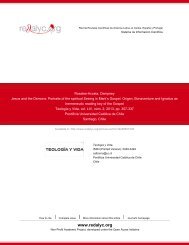A Key Concept in Modern Translation Theory - Redalyc
A Key Concept in Modern Translation Theory - Redalyc
A Key Concept in Modern Translation Theory - Redalyc
Create successful ePaper yourself
Turn your PDF publications into a flip-book with our unique Google optimized e-Paper software.
SERGIO BOLAÑOS CUELLAR<br />
77<br />
Some aspects should be highlighted <strong>in</strong> Koller’s proposal <strong>in</strong> relation to the<br />
concept of equivalence. First of all, it is clear that equivalence is the key<br />
constitutive concept that allows one to recognize the relationship that holds<br />
between an SL-text and a TL-text as a translation. Thus a dist<strong>in</strong>ction can be<br />
drawn between translations proper and other secondary l<strong>in</strong>guistic products such<br />
as paraphrases, adaptations, summaries, etc., <strong>in</strong> which case there exists a l<strong>in</strong>k<br />
between an SL-text and a TL-text but of a different nature, i.e., the TL-text can<br />
also be an orig<strong>in</strong>al text which is only distantly related (thematically or structurally)<br />
to the SL-text. A second aspect stressed by the author has to do with the existence<br />
of a double-bound relationship of equivalence with regard to the SL-text and the<br />
TL receiver, which prevents us from reach<strong>in</strong>g borderl<strong>in</strong>e cases such as wordfor-word<br />
translations and orig<strong>in</strong>al (not translation) TL texts. F<strong>in</strong>ally Koller’s<br />
proposal of frames of equivalence to dist<strong>in</strong>guish five types of equivalence is<br />
very <strong>in</strong>terest<strong>in</strong>g. However, we consider that this <strong>in</strong>itial po<strong>in</strong>t of reference needs<br />
further elaboration. In Koller’s proposal it is not clear what the underly<strong>in</strong>g<br />
conception of translation is and how it helps to give coherence to the proposed<br />
differentiation of frames of equivalence. In other words, one may th<strong>in</strong>k that<br />
these frames of equivalence are <strong>in</strong>dependent and, to some extent, unconnected.<br />
Neither do we f<strong>in</strong>d any exemplification of how these frames could be actually<br />
put <strong>in</strong>to practice, that is, made operational. We attempt to deal with this issue <strong>in</strong><br />
the next section.<br />
6. EQUIVALENCE WITHIN THE FRAMEWORK OF A DYNAMIC<br />
TRANSLATION MODEL (DTM)<br />
In our proposal of a Dynamic <strong>Translation</strong> Model (DTM) (Bolaños 2001),<br />
we attempt to show that translation should always be understood with<strong>in</strong> the<br />
framework of a communicative process. A simplified graphic representation of<br />
our model would be:
















